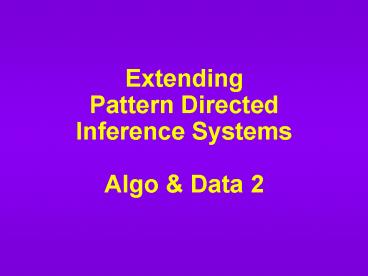Extending Pattern Directed Inference Systems Algo - PowerPoint PPT Presentation
1 / 16
Title:
Extending Pattern Directed Inference Systems Algo
Description:
Extending. Pattern Directed. Inference Systems. Algo & Data 2. Extending the basic PDIS model ... How to increase the logical power of the system. How to ... – PowerPoint PPT presentation
Number of Views:25
Avg rating:3.0/5.0
Title: Extending Pattern Directed Inference Systems Algo
1
Extending Pattern Directed Inference
SystemsAlgo Data 2
2
Extending the basic PDIS model
- How to increase the logical power of the system
- How to increase the efficiency of the system
3
FTRE Changes
- Syntax changes
- Triggers are now a list, interpreted
conjunctively - rassert! to remove backquotes
- Examples(rule (show ?q) (rule (implies ?p
?q) (assert! (show ,?p))))becomes(rule
((show ?q) (implies ?p ?q)) (rassert! (show
?p)))
4
FTRE Syntax Trigger keywords
- VAR next item is a variable to be bound to
the entire preceding trigger pattern - TEST next item is lisp code executed in
environment so far. If NIL, match fails. - Example(rule ((show ?q) test (not
(fetch ?q)) (implies ?p ?q) var ?imp)
(debug-nd BC-CE Looking for A to use
A.. ?p ?imp) (rassert! (show ?p)))
5
Problem We need more inferential power
- Implementing full KM requires the ability to
make and retract assumptions - Indirect proof, negation introduction,
conditional introduction, etc. - Implementing search procedures more generally
requires ability to make and retract assumptions - Example N-queens problem
6
Key idea Logical Environment
- The logical environment of a computation is the
set of assumptions upon which it rests. - Every program has a logical environment.
- In AI programs, a substantial fraction of that
logical environment is represented explicitly in
the programs data structures. - How to represent and manipulate logical
environments is a key issue in problem solver
design.
7
Stack model of logical environments
- Each operation that makes an assumption pushes a
new stack frame. - When the operation is finished, the stack is
popped. - Supports depth-first exploration of set of
assumptions
8
Initial state of database
- (show P)
- (not Q)
- (implies (not P) Q)
- (implies (not Q) R)
9
Start of indirect proof attempt
- (show P)
- (not Q)
- (implies (not P) Q)
- (implies (not Q) R)
(not P)
10
After CE on assumption
(show P) (not Q) (implies (not P) Q) (implies
(not Q) R)
Q Contradiction
(not P)
11
After successful indirect proof
(show P) (not Q) (implies (not P) Q) (implies
(not Q) R) P
12
Constraints on Assumption Stack
- Every assertion must be made in the newest
context. - Guarantees retraction when assumption is
retracted. - Conclusions must be drawn in simplest possible
logical environment - Prevents inappropriate retraction
- Every operation that requires an assumption must
push a new context. - Otherwise could over-retract
13
Improving efficiency
- In TRE, alignment of logical variable bindings
with Lisp variable bindings achieved via eval on
a constructed let statement. - Inefficient. Should be able to compile rules.
- Trick Turn rules into procedures
- In TRE, pattern-matching was handled via calls to
unify - Observation We know one of the patterns already.
- Trick Open code unification
14
Making rules compilable
- Body of rule is lisp code -- should compile it
- (Always compile your code! The error-checking
alone is worth it.) - Implementation in TRE wont do
- Define a separate procedure for the rule body
- Arguments are the pattern variables used
- Do it automatically, user just writes rules
- Issues
- Must create the appropriate environment
- Must arrange contents of files so that procedures
are defined before they are used, because
matching facts can already be in the database.
15
Open code unification
- At compile time we know
- Structure of trigger pattern
- What variables will already be bound
- Any additional tests required.
- Idea Create special-purpose procedure which does
what unify would do on the trigger pattern - Rule match procedure and body procedure
16
Implementation issues for efficient rules
open-coded unification
- At rule expansion time, must process all
subrules. - Must keep track of variables that will be bound
at run-time, to ensure that the appropriate
lexical scoping is enforced. - Tests performed by the unifier must be unrolled
into a procedure. - The rule and body procedures must have their
argument lists set up correctly.































